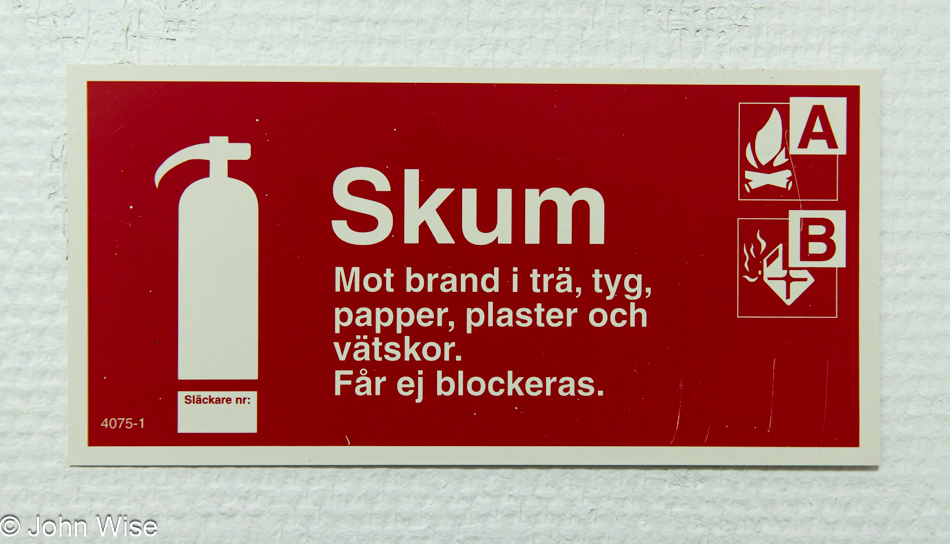
A funny thing about this language puzzle is how quickly it exposes the idiot that still dwells within me. I’m drawn in due to my puerility because, for me, the word “Skum” triggers a second glance and a chuckle about putting out a fire with scum. Now I have to stop and think, what is shot from a fire extinguisher? Foam is the answer, and that’s what the Swedish word Skum translates to, so this sign only brings attention to a fire extinguisher at this location in our hotel. It turns out that Skum is derived from the Middle Dutch word Schume meaning froth or foam, and that word originates from Proto-German Skuma, which means shallow ladle for removing scum (German: Schaum). Next, I will examine the etymology of the English word scumbag, which is slang for condoms.

While getting ready to take on the day, I’m taken by how fluid Caroline’s and my cooperation with each other is. Often in synch and moving toward a common goal, it’s a kind of dance we go through from the moment we first face each other upon waking up until we fall asleep. For this to work, there can be no taking advantage of each other. As those who know me are aware, I need not work for money, but I’m well aware that I cannot waste any time I am afforded in uncertainty or lack of productivity. I understand the rarity of the gift of time I can invest not only in myself but both of us. Whether I’m writing, reading, talking, or involved with some type of craft, I’m evolving – which, if I’m fortunate, will benefit the two of us. There is no time for TV, games, or professional sports as they are counterproductive and, in my view, destroy or at least harm one’s chance of finding real happiness. I do not live vicariously. I create new memories, share experiences, and, on occasion, revel in what we’ve been able to accomplish.
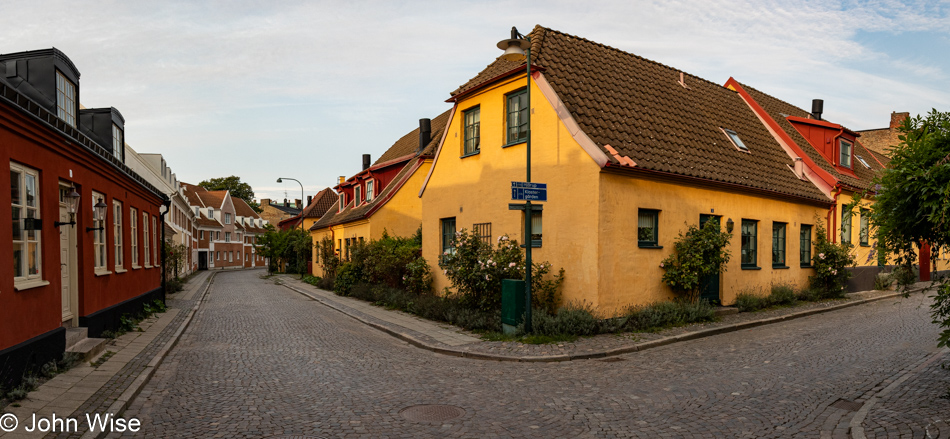
Yes, I’m an atheist, but that has never stopped me from looking for divinity in solemn places. I try to live in the moment but never stop searching for a sense of time in historic sites. I’ve seen things in ways that bring tears to my eyes, yet I’m always on the lookout for more because tears are not only about suffering.

I picked an apple from this tree hanging over the sidewalk only to find that it was a fall apple and needed another month or two to fully ripen. No matter, we shared the apple as we are not ones to throw food away, especially when it was taken while walking the streets of an urban area in a different country. As I’ve said somewhere else on this blog, we are unaccustomed to finding food in America’s cities that have been sterilized of things that are edible.

Our walk away from the hotel this morning had us dragging our bags to the Lund main train station to store them in a locker. We have tickets to Gothenburg, Sweden, with a departure time of 2:15 p.m., well after our checkout.
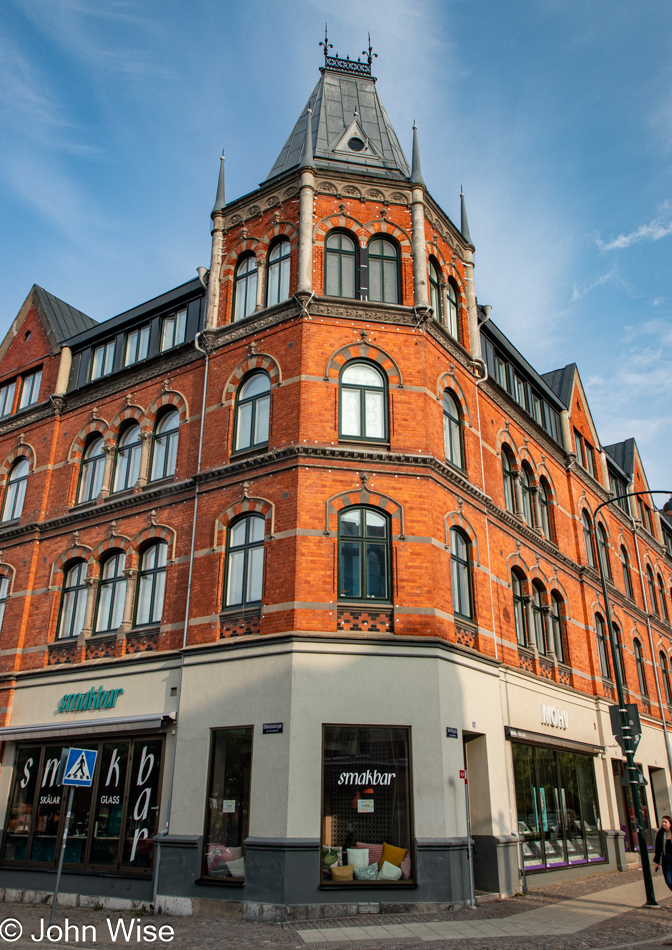
Triggered again! Is this a heroin bar (American slang: smack), snack bar, or ice cream shop? I had no idea that smak meant taste or flavor, but now that I do, I wonder if this is related to the German word schmecken. [It is indeed – Caroline] Visiting the Facebook page of this shop, I learned that it’s an ice cream parlor, a place to get a different kind of fix.

There seem to be buildings everywhere that belong to Lund University, but I guess that’s the way things have to work when you fit a university into a city that’s already 650 years old. The university was founded in 1666, and during the intervening 357 years, the school has continued to grow and is considered one of the top 100 universities on earth. This particular building is being utilized as part of the Kulturskolan or School of the Arts.
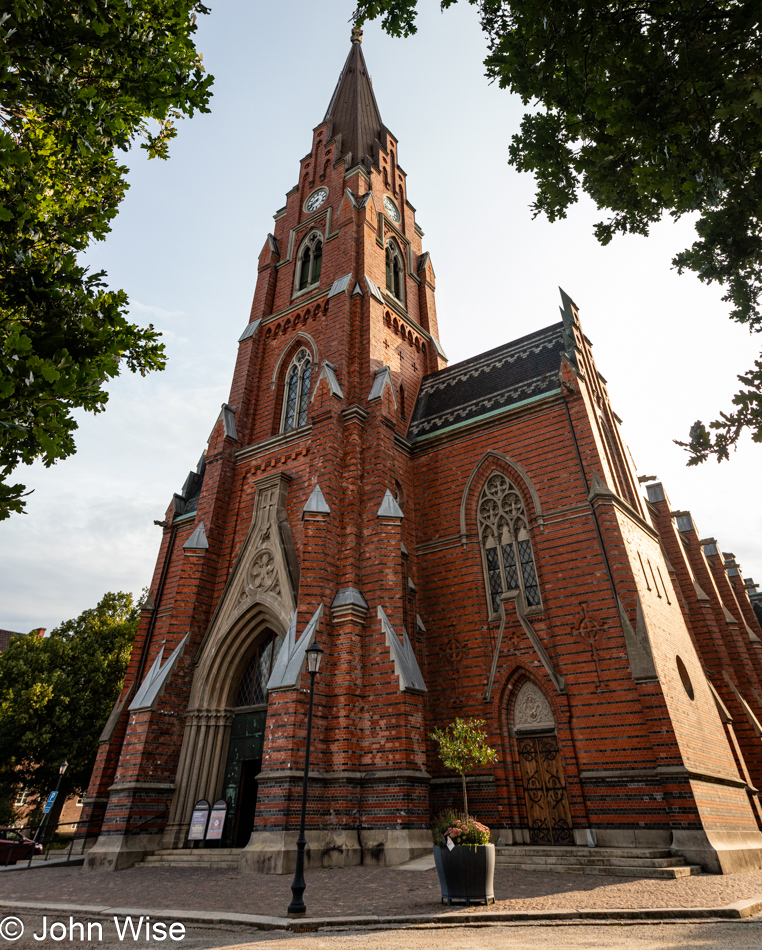
We don’t typically visit churches less than 500 years old, but we are making an exception today to visit the Allhelgonakyrkan (All Saints Church) consecrated in 1891. Just kidding, age has nothing to do with our decision to visit a church; only an open door stands between us and our visiting a house of worship.
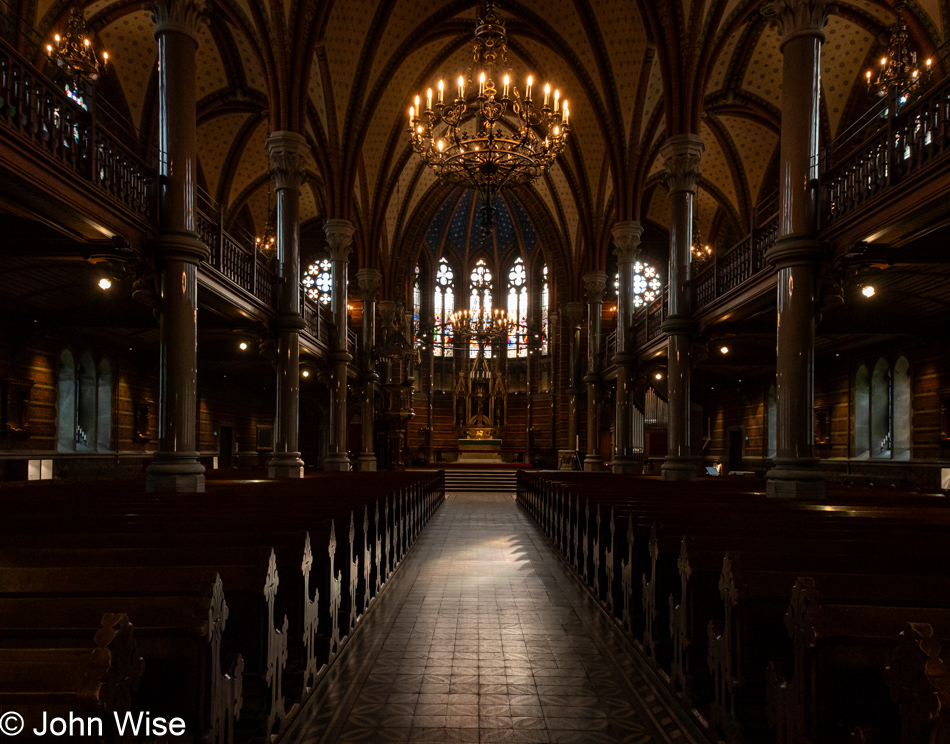
Here we are in the sanctity of a space created for gathering, but we find ourselves alone. The idea is that those who enter these domains are looking to commune with the holy spirit, align their soul, or seek knowledge and compassion to comfort themselves or a loved one, and yet, time and again, the masses do not turn to the modern church because the thing that most satisfies what ails them is to be found in the form of cash.
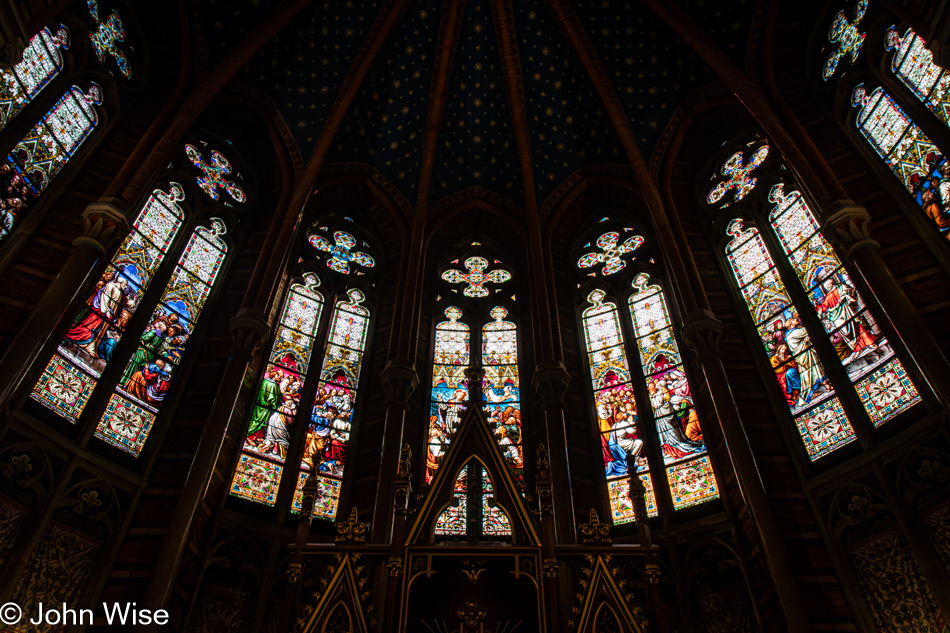
Aside from tourist attractions and the occasional setting of a wedding, have our churches become relics of a time where belief was the primary vehicle for one’s life and these buildings the highway to deliverance? I cannot infer that there is nobody left who wants to worship and seek guidance because I certainly witness them taking a place in an otherwise empty pew and looking to heaven in prayer. By and large, though, visions of God are mostly gone and forgotten in a different age. Ears that at another point in history were tuned to hearing the collective prayers of others in pain and anguish in order to build community have fallen into deafness while simultaneously, we turn a blind eye to tragedies that are too great a burden for the souls of good capitalists. And yet, when it comes to riches, we all aspire to don the cloak of the holiest, most righteous, and deserving and believe that God is looking over us and our good fortune, others be damned. This idea that we’ve absolved ourselves of doing the work of God so we can relish in the glory of wealth is an evil contradiction of the tenets of religion that put the health and welfare of all people above the few.
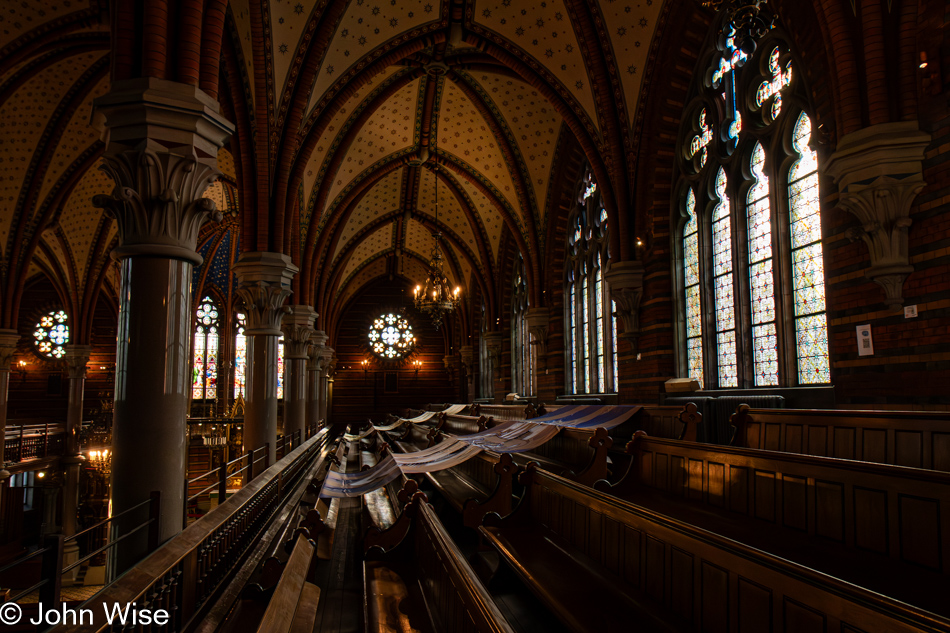
The time is lost when people turned to their souls and, in community, found the essence of God. Love always rang through the congregation, even if it was only for an hour on Sunday. Today, self-love is found in financial transactions that beatify our existence and aloft us to nirvana. Today, Amazon offers us the kind of salvation that was once found in the church, with the media acting as the Pope, extolling what is cool.
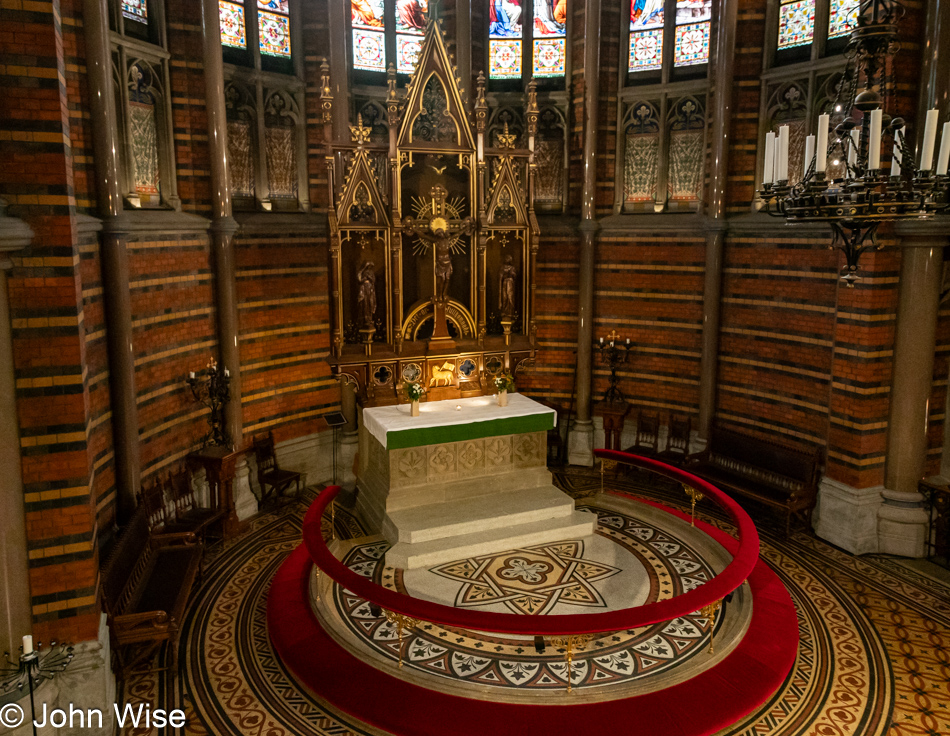
The altar is archaic, appreciated by the atheist more than the devout, as the aesthetics are unique and fit the inquiring mind of the godless individual searching for the uncommon and unknown. What is offered to the senses in the church are not on-brand mass-produced goods that anoint the herd with salvation through consumption; this sanctuary of the holy is no longer a refuge for those trying to find their way or discover deeper truths in the unknown. It is painfully obvious that a church exercising its power to the point of being shoulder to shoulder with the most powerful is corrupt, but if God is supposed to be in the heart of all people, then why does the rage of intolerance and expression of greed infect such vast numbers of people? I am one of those who do not believe in a God, and yet my heart is overwhelmed with the need to know the extent of how far I can love and how loudly I can beg for the divine to be known. My voice, though, is not to be heard as I’m not on the “Viral Plan.” I’m not standing in the pulpit of TikTok or on a stage displaying the physical attributes everyone desires to worship. I’m just a nobody atheist, but I’m also profoundly in love.

Are You A Communist? For over 50 years, Sweden has had a communist party, which isn’t all that strange in Europe, though it would certainly seem quite wrong for Americans. Consider for a moment that they are not represented on the national level and only have a few seats in local municipalities, while the Pirate Party back in 2009 captured enough votes to gain a seat with the European Parliament. Don’t worry yet about the communists yet as over in Germany, AFD (Alternative For Deutschland – might as well call them Nazis) has a bit more than 10% of the seats in parliament. [The German Communist Party or DKP is absolute fringe in comparison and has no seats at all – Caroline] Such is the nature of politics not controlled by two monolithic parties where stalemates are the rule.

Flowers don’t give a damn about war, history, technology, or any of the other silly machinations of people bent on control, intimidation, and fear. Flowers have their own Freedom Party with a single platform that demands the right to sway in the wind.
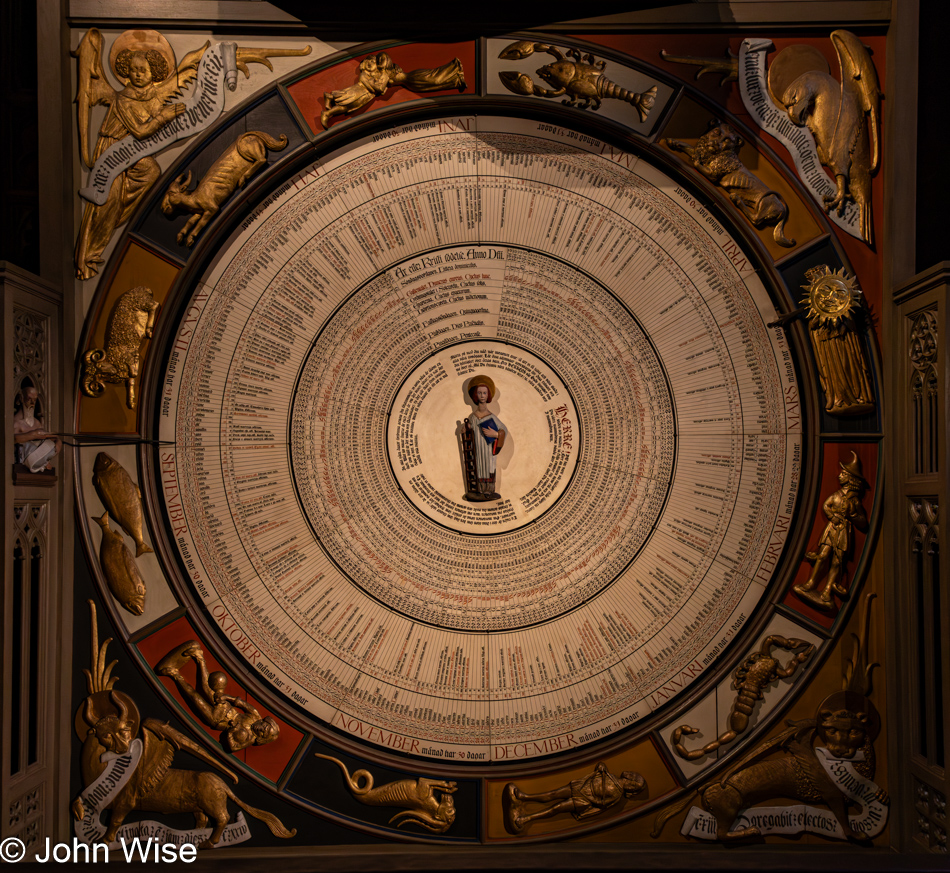
We have returned once again to the Lund Cathedral because it’s not busy at this early hour, and we want to visit the crypt without others milling about. The cathedral is already open, while our next destination doesn’t unlock its doors until 10:00 a.m. We’ll have to return for a third visit to the cathedral since the astronomical clock will not play until noon and then again at 3:00, but we’ll be on our way north by that time.
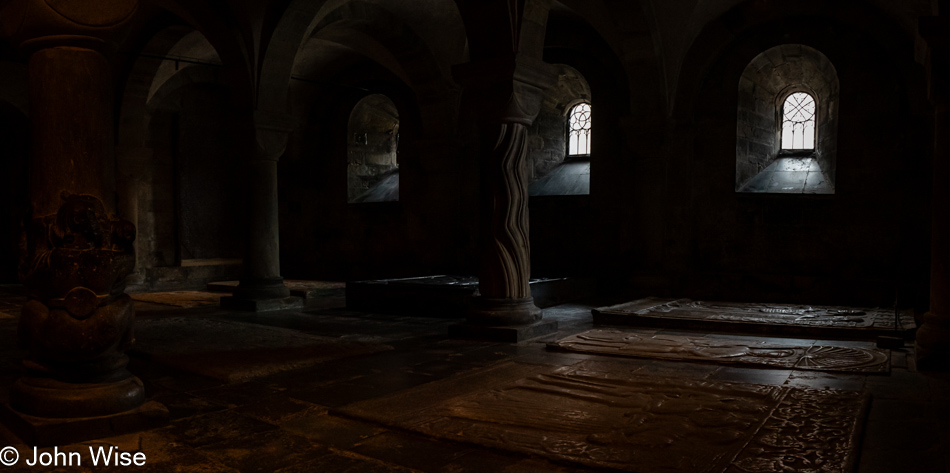
A sense of palpable excitement grips me upon entering the crypt of a church. When descending into such places, there is a charge that does not originate in movies or books but is, in my opinion, inexplicable and mysterious. The solemnity is greater down here than on the floors above or in hospitals and libraries. Remember, I don’t or do not want to believe in spirits, ghosts, or souls of those who preceded my joining this space as a visitor, and as far as I know, my imagination doesn’t play to entertaining such mysteries as having weight or authenticity. Yet, there are times when the perplexing presence of historical gravity seems to be present in ways I cannot truly comprehend.
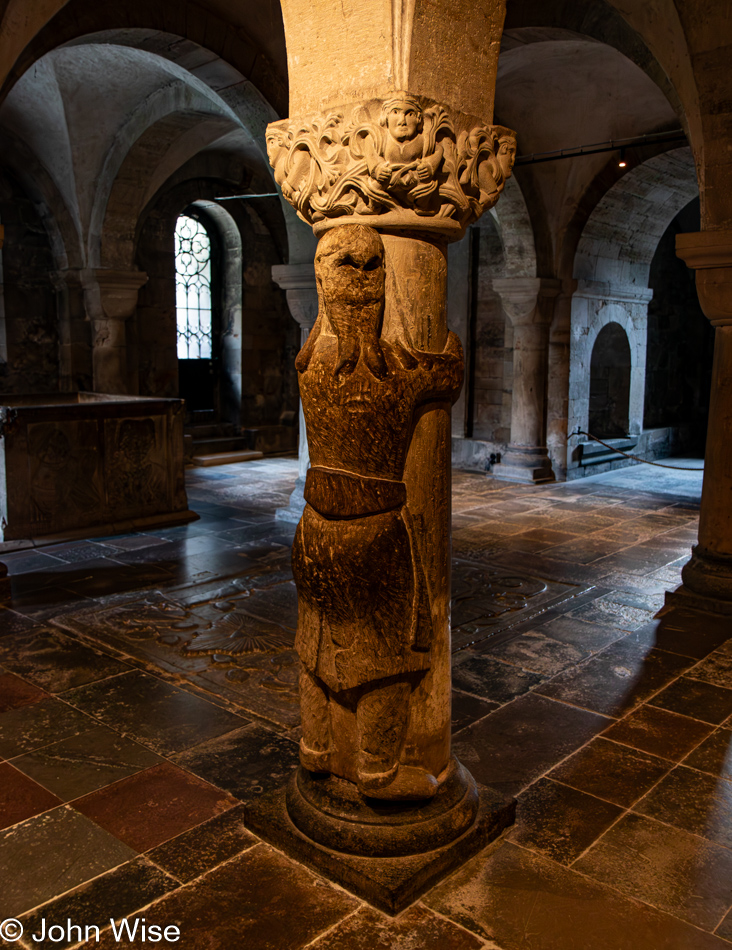
Legend has it that this is Finn the Giant, who made an agreement with a troll, but something went sideways, and now Finn stands here in petrified form, helping hold up the church.
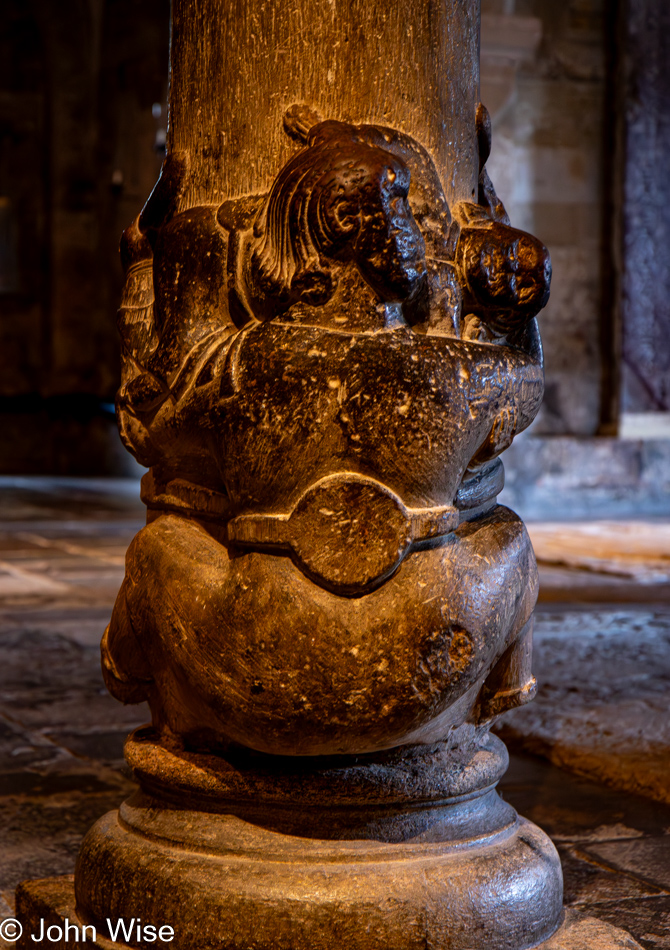
This is Finn’s wife and child, holding fast to another pillar. What the truth of the matter is and who they represent is lost to time, and that’s perfectly okay as humanity is rarely interested in truths when a good story is at hand.
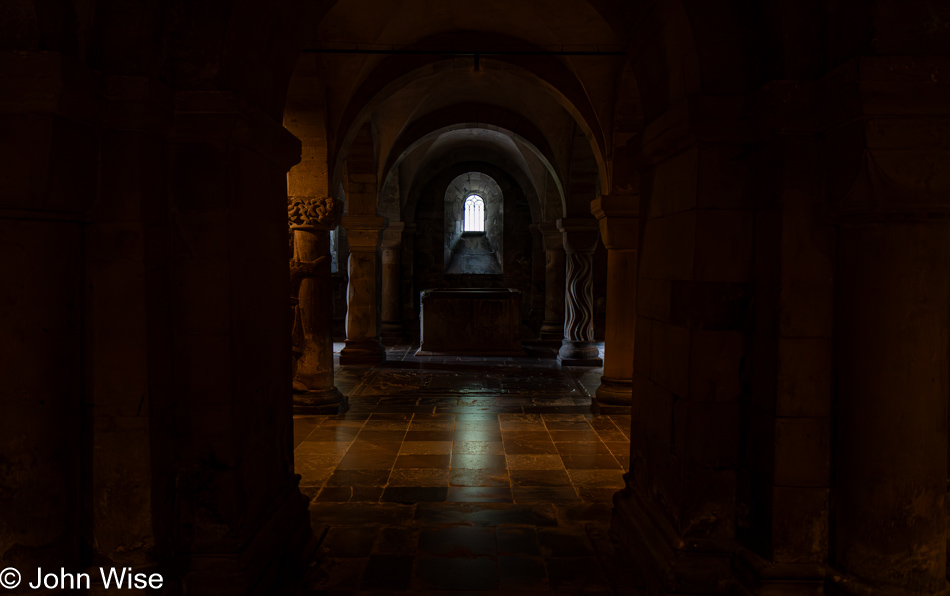
The oldest grave down here is of Hermann of Schleswig buried in the 12th century, but when the last burial was has proven impossible to determine.
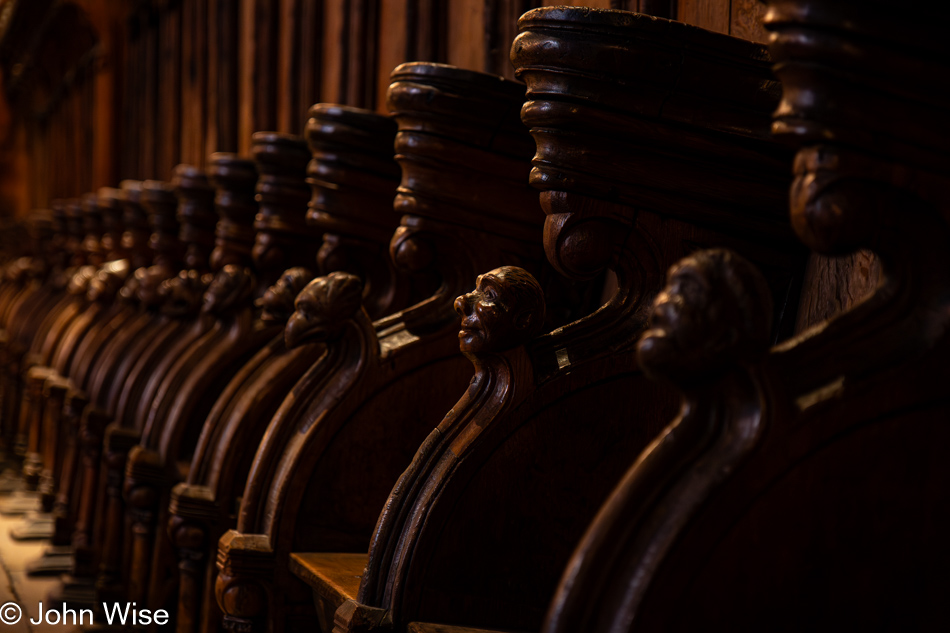
There are two rows of medieval choir stalls that not only are some of the largest Gothic carved wooden sculptures anywhere but have been in place since the late 14th century, surviving for more than 600 years.

There are a total of 78 seats and not one of them has been sat in by me or Caroline. This concludes our second visit to the Lund Cathedral.
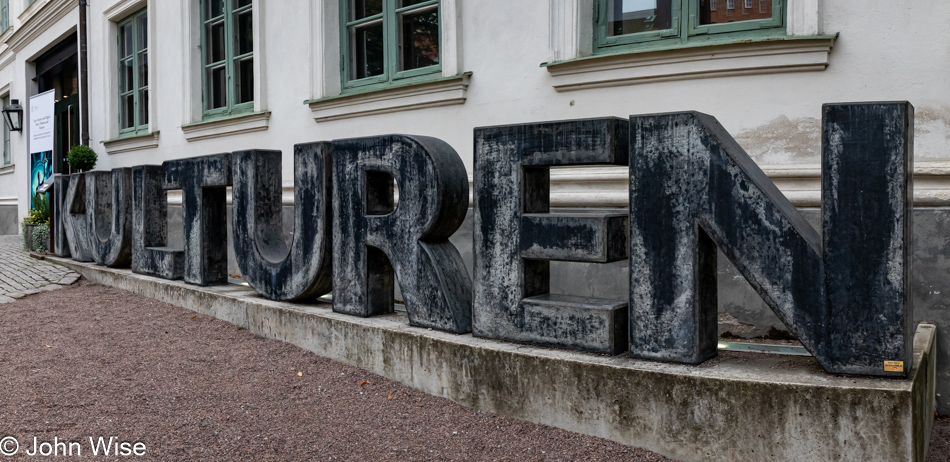
With time to spare before the astronomical clock sounds at noon, we walked over to Kulturen i Lund (Museum of Cultural History) to visit the outdoor living history museum.

Yesterday we saw our first runestone that was weathered, incomplete, and hidden in a dark space, but this one is magnificent and complex, at least in our eyes. This runestone dates to the year 1000, is carved in the Younger Futhark runic alphabet, and reads, “Káulf and Autir set this stone in memory of Tumi, their brother, who owned Gudis Snape” which is now the small village of Gussnava down near Ystad.
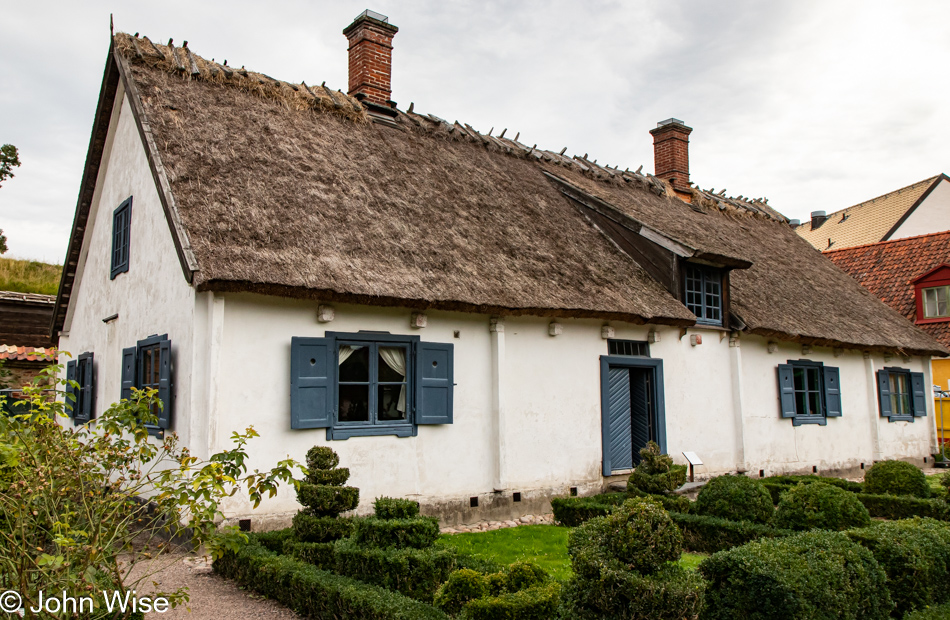
The first thing that comes to mind in this Museum is Colonial Williamsburg back in Virginia, except it’s Swedish, located in Europe, and older.
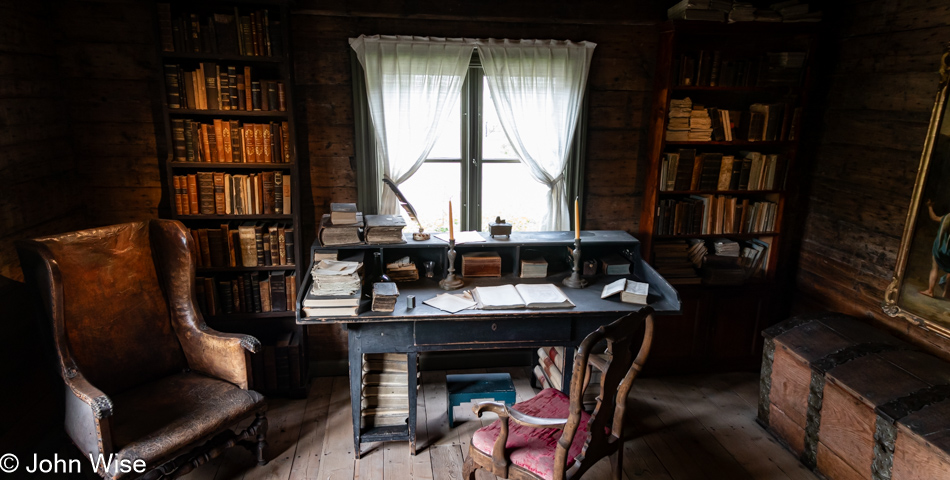
This is the world’s second-oldest open-air museum after Skansen in Stockholm.
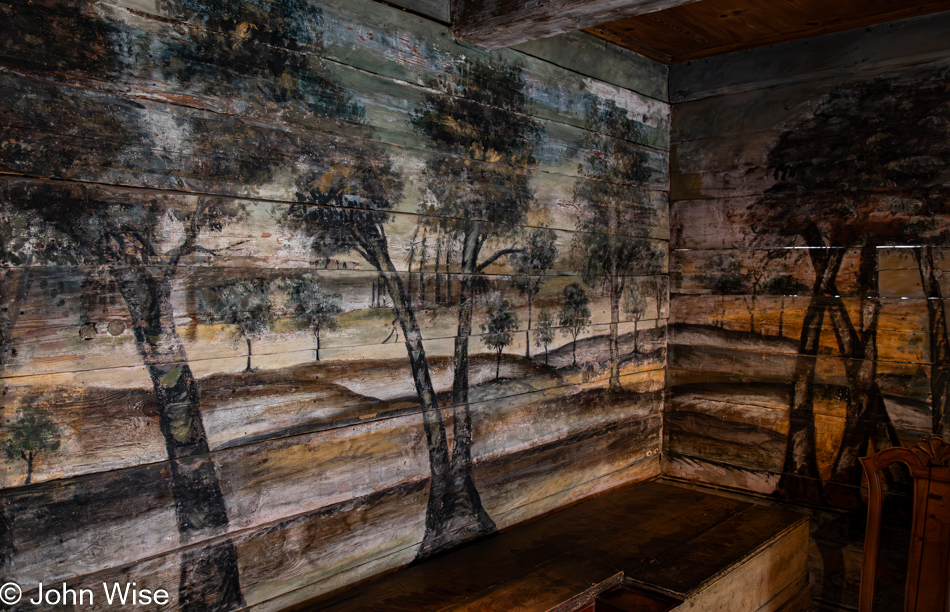
As the museum was taking form back in 1882, there still existed many buildings from the Middle Ages up to their present that the museum could relocate from the surrounding areas, and that’s just what they did. According to the literature, everything is authentic, and we assume the wall paintings are, too; I wish this kind of stuff was on our walls.
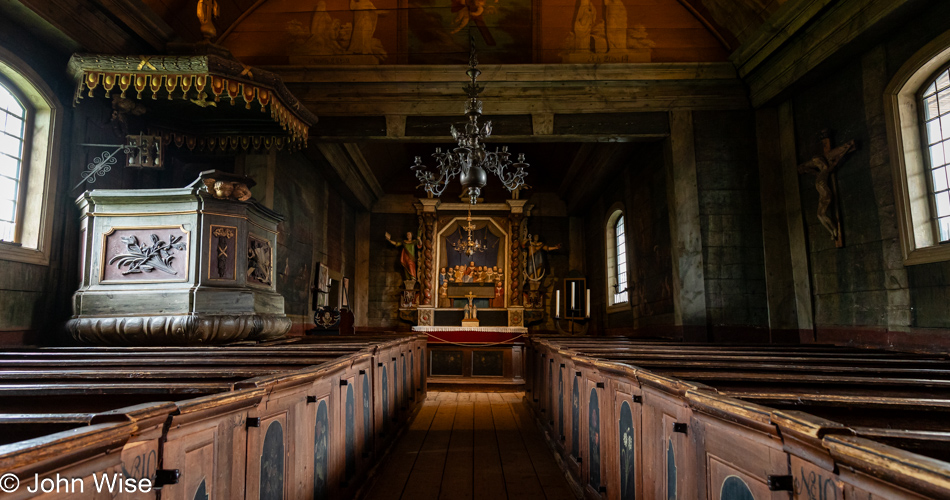
With only a little more than 90 minutes at the museum, we are rushing through the grounds which is easy enough, seeing it’s a Thursday outside of the main tourism season. Due to the time of year that we are here, there are no demonstrations going on, which expedites things, too, although we are left to wonder how much excitement we are missing.
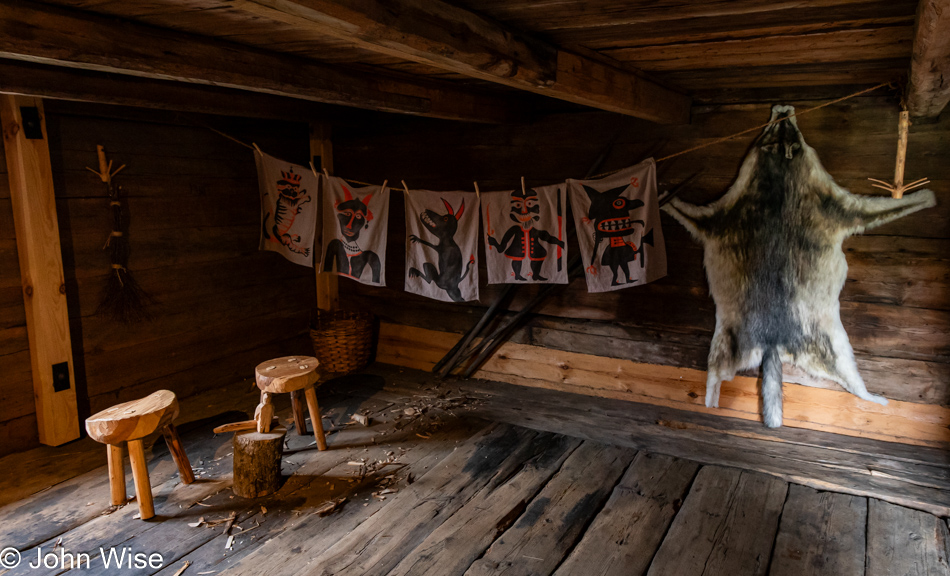
There is so much we could reach out and touch, there are no cameras, and no docents sitting by watching visitors. Most likely, in the United States, people would have carved their names into things, taken souvenirs, or posed with the displays in ways that would be disrespectful to the exhibits. Now, I’m sure that the figures hanging against the wall are not authentic historic pieces and that the stools are modern, but that a lot of this stuff can be unattended by security, unobserved by surveillance, or behind protective barriers should be noted.

If only eco-tourism were to turn to eco/history tourism, we could spend a week in an environment that eschewed particular conveniences, allowing visitors to experience life outside of time.
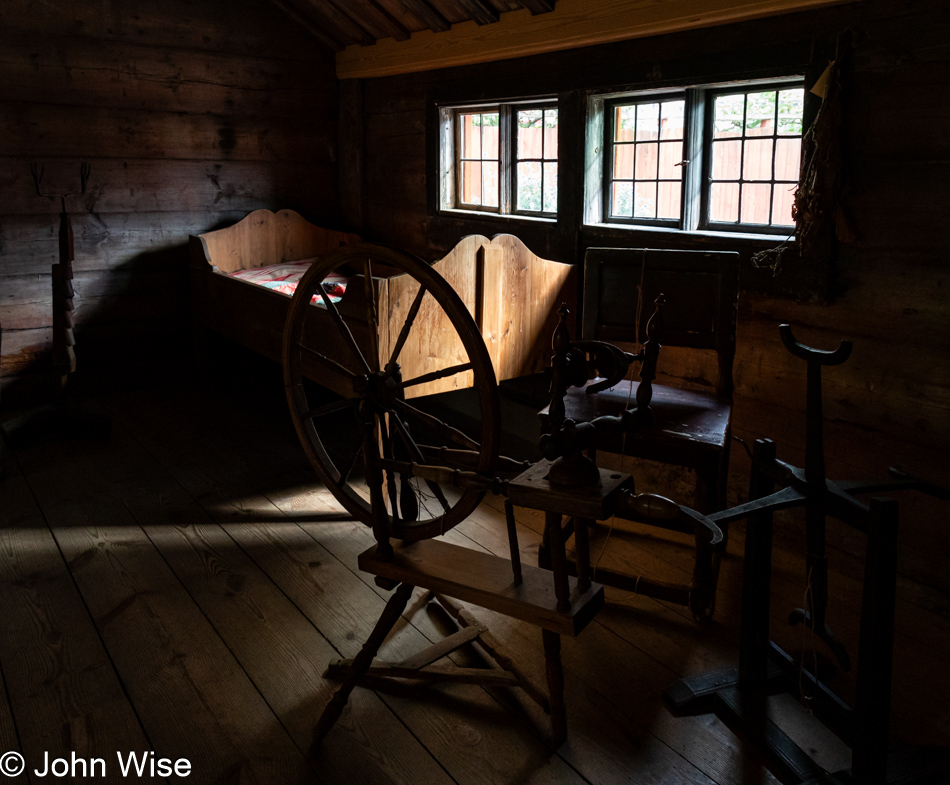
An old farmhouse with a spinning wheel, loom, and other fiber-related tools would keep Caroline busy, while a library and a writing desk could easily occupy my time, making for a world-class vacation.

I don’t typically have a good impression of open-air museums as my sense is that they are heavy-handed affairs with all of the authenticity of a Renaissance Festival in the Arizona desert, but the presentation here in Lund is excellent and nearly fully immersive. There are some worker vehicles nearby and a bit of scaffolding for a building that’s being preserved, but aside from that, it’s pretty easy to get lost in history. Most of the signage offering historical tidbits (down to the names of previous occupants and their stories) is bilingual.

I suppose in a litigious society with liability insurance and draconian rules regarding access and exposure to hazards like low doorways where someone could “crack their skull,” those things become the reasons why the edges are being removed from public spaces. And then, details such as this roof cannot exist because when you pay people minimum wage in the American economy, the skills to support such things don’t add up. There are moments that I feel nothing adds up in the United States when it comes to quality of life unless you are incredibly wealthy and can exist in a gated fortress.
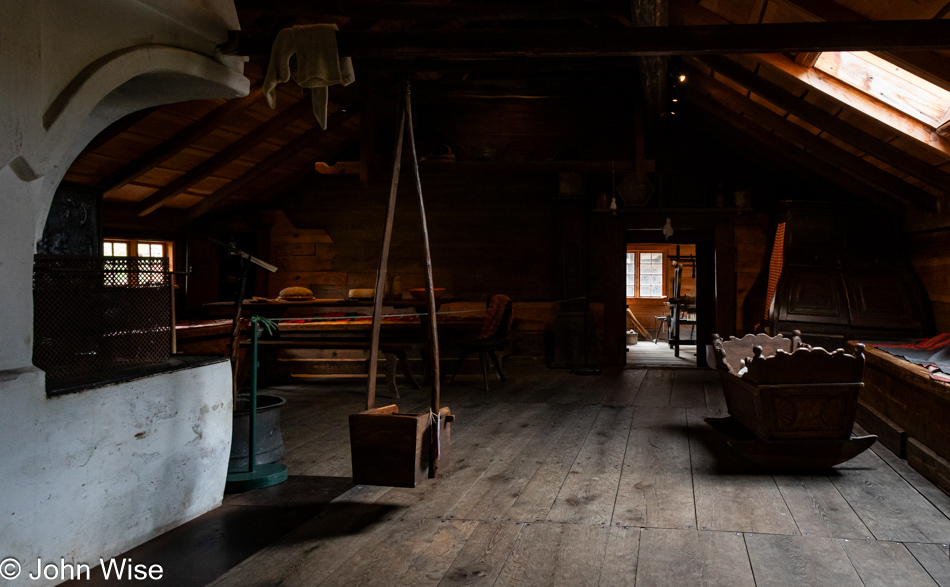
The American aristocracy of 100 years ago was able to buy up untold numbers of art and treasures to decorate their mansions. While people like Industrialist Andrew Carnegie became philanthropists funding a myriad of libraries, the investment in the public space has really only benefited those of means. For example, sure, we have museums, but the best ones are in New York City, Chicago, Washington, D.C., Philadephia, San Francisco, and Los Angeles, while here in Europe, it’s not uncommon to find treasures in small out-of-the-way places such as Lund, Sweden; Stuttgart, Germany; or Ostend, Belgium. I suppose it’s simply one of the defining characteristics of a culture that invests in quality of life compared to one that invests to see how concentrated wealth can become.

Out of view on the right is a loom, while before us is a bundle of flax and the requisite tools to start turning it into linen fibers.
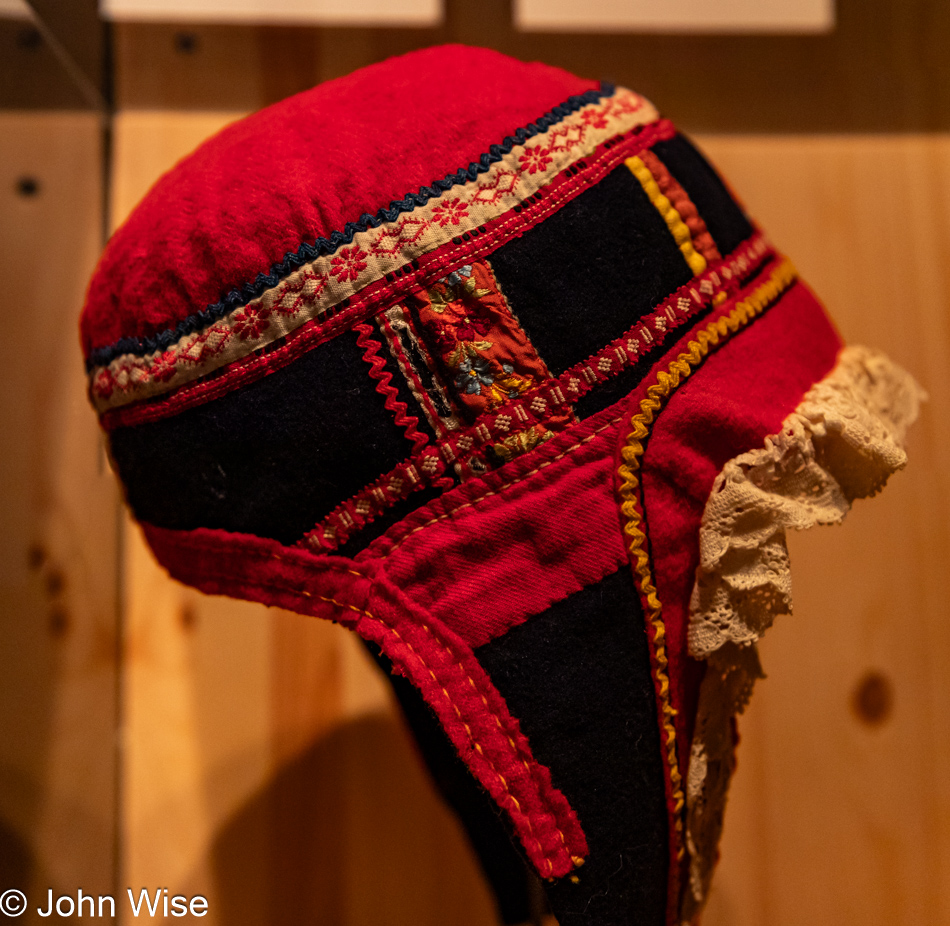
There was an exhibit going on during our visit dedicated to sharing cultural information about the Sámi people of northern Sweden, Norway, and Finland, but we needed to beat feet back over to the cathedral as our 1-minute concert would begin soon, and we couldn’t miss it.
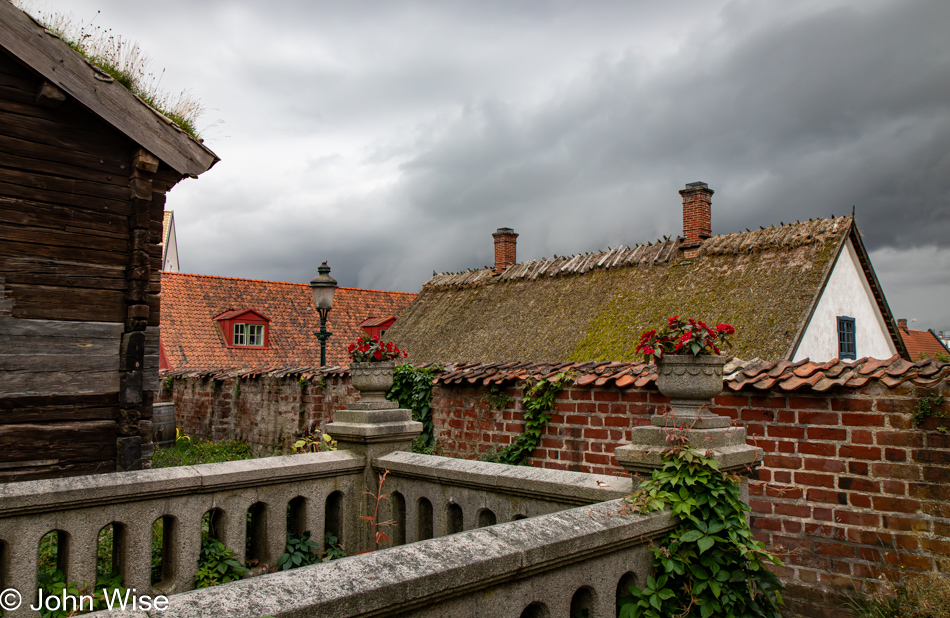
The weather is turning ominous while the view appears medieval.

Life should be accompanied by on-demand guides knowledgeable about everything we could possibly want to know about, such as these crazy psychedelic sculptures at the closed side entrance of the cathedral.
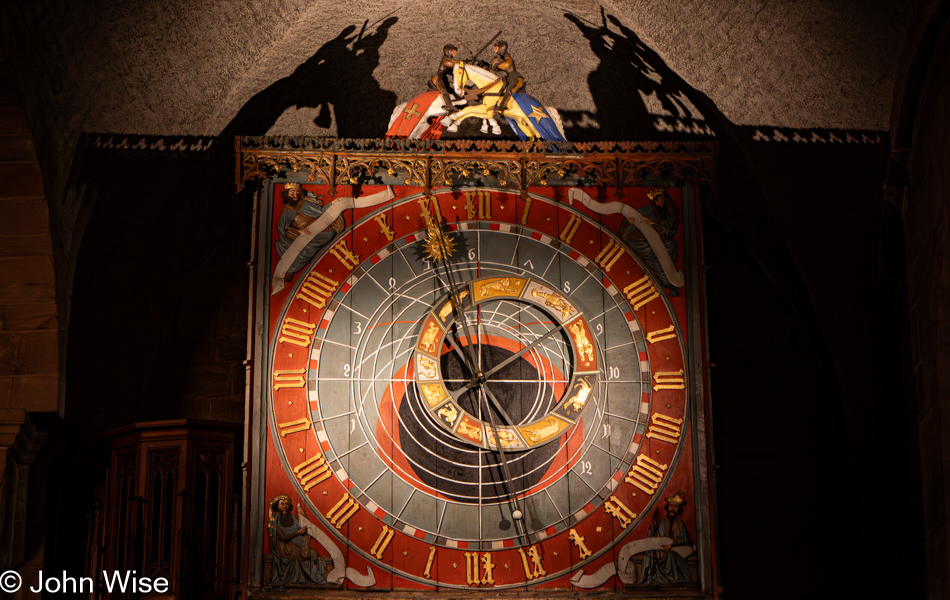
For hundreds of years, these knights have raised their swords to do battle, never having resolved the conflict…
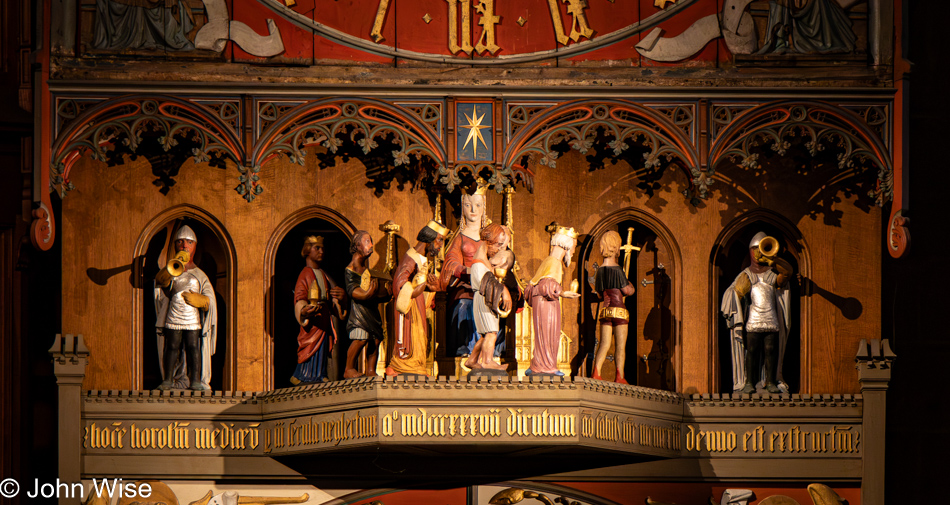
…while this procession rarely fails to emerge from the darkness to make an appearance charming those in attendance.
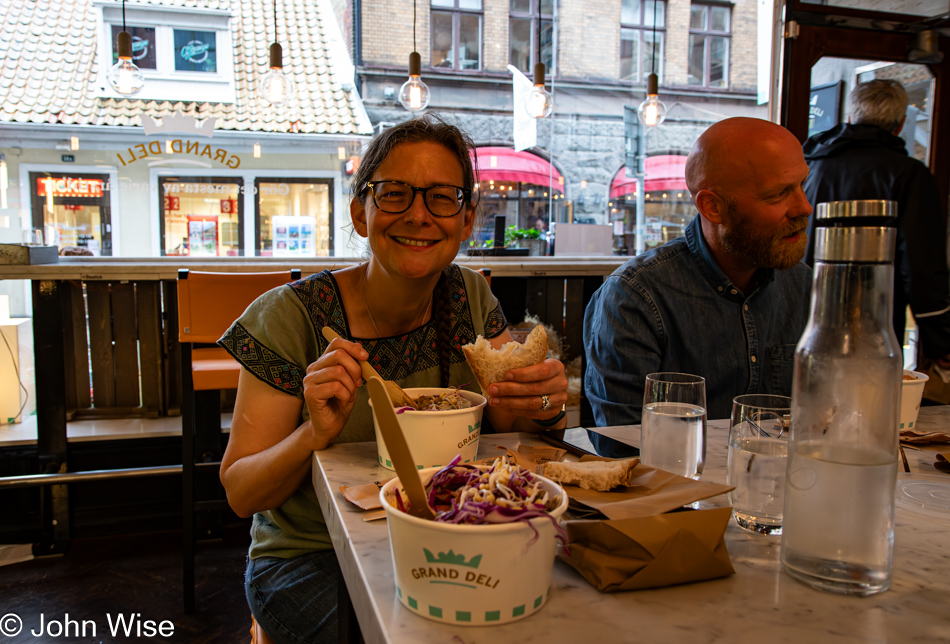
On the hunt for lunch, we passed what is obviously a popular place, it’s called Swedish Express and with a dozen people in line and very limited seating, we had to skip this opportunity for more Swedish meatballs as it was raining. Down a couple more doors, we entered the Grand Deli, snagged a couple of places to sit, and got ready to eat whatever they had. Great choice this was, even though they have a very limited lunch menu featuring two different daily offerings. Today was either a lentil-based vegetarian bowl or a pulled pork version that was nearly the same; I ordered one of each.
Our mid-day meal in this little gourmet joint that doubles as a small market was delightful. Bread and a bottle of chilled water were included. This was not our first encounter with the kind of utensils we were provided; they are biodegradable and compostable made from various natural materials such as rice husk, bamboo, and/or wheat straw. Mind you, this attention to detail we might expect from a hipster pricey spot in NYC, SF, or LA, but in the city of Lund, Sweden, with a population of just around 100,000, this feels extraordinary to me.
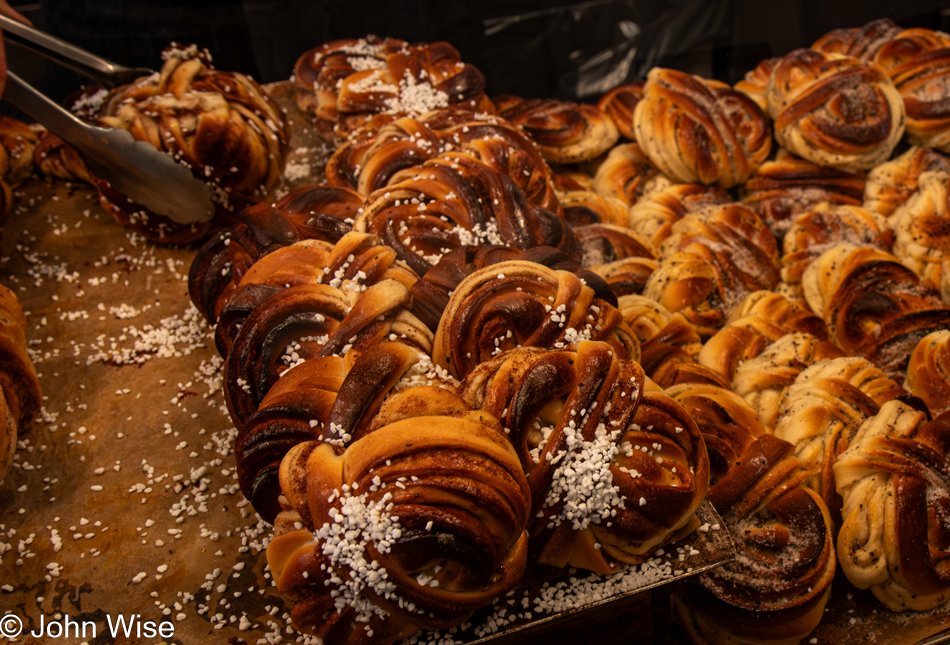
A couple more doors away is Broder Jakobs Cafe, where we picked up the fixings for a fika under the back patio awning in the rain. Armed with a cinnamon and cardamom roll and two coffees, we were punctuating our short visit to Lund with perfection.
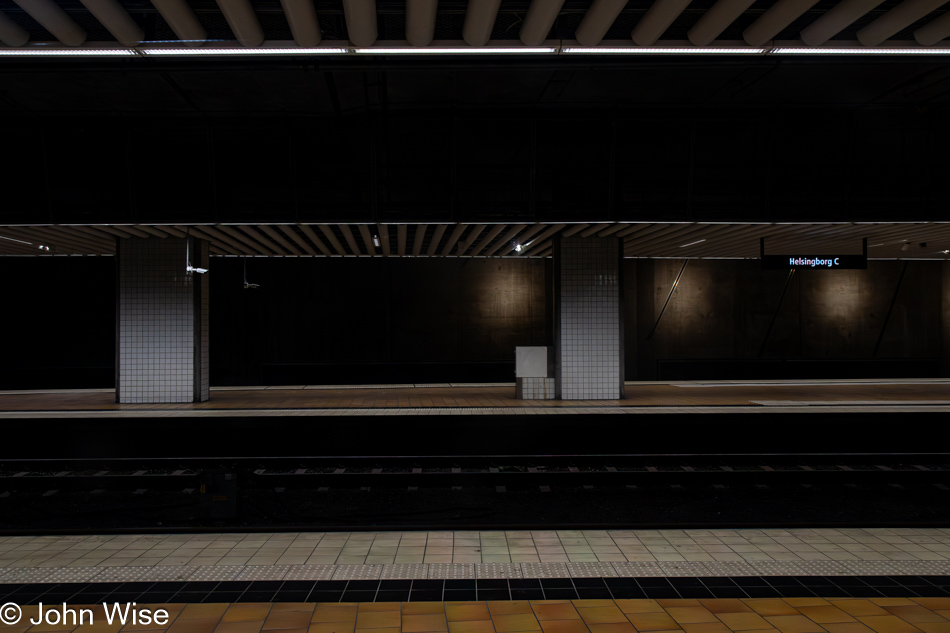
We left Lund under a light rain for the 2.25-hour train ride to Gothenburg, where I was hoping there would be no rain. This was the first time on vacation that I found a large block of free time to sit and ponder things, but the hat of profundity was missing, and the hope of whipping out some writing I could be proud of felt far away. Even some bad writing to be properly embarrassed by if it’s stylistically poor enough is desired and preferred over more mediocre blatherings that typically represent the “Did this, went there, saw that” bit of crap that made up the majority of notes taken at this juncture of our trip.
I was busy trying to distract myself by looking out the window as we sped along at 200 km/h (125 mph) over the murky landscape beneath gray skies, passing plowed fields, occasional plots of corn, and even a windmill, but as I gazed into the world racing by, nothing in my mind said: “Get ready for inspiration.” On the contrary, the whispers of crickets and light flutter of cobwebs suggested that the cavernous space between my ears had been vacated.
I hoped I’d be saved by the first stop on the route as we pulled into Helsingborg, and my camera talked to me, telling me to make art or at least take a photo so that upon committing these handwritten notes to the computer upon returning to the U.S., you might have an image that could inspire something or other. But here I am so many weeks later and have nothing to add, so I transcribe my notes and move on.
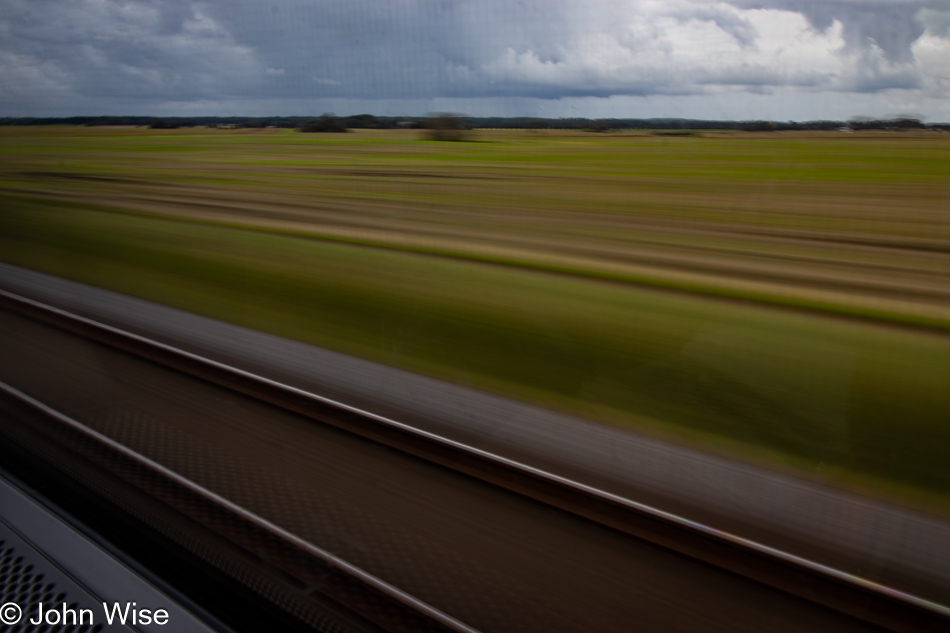
Maybe part of the problem is that there has been no idle time to stop and reflect on the collection of impressions that are falling into our senses at a frenetic pace. With an empty head, I find myself focusing on distractions I can use to further distract myself by blaming others for what I’m missing. There’s a clone of a generic businessman to our left who is mad-typing with a serious urgency that is destroying my 1st class experience. Then there’s the Covid cougher a couple of rows over who is hacking incessantly. Sweet god, someone a few rows ahead is aggressively unwrapping another bonbon, possibly the sixth or seventh bonbon, with cellophane crinkles that are likely disturbing people in other cars. I’ll certainly become unhinged at this rate because how many damn bonbons does one need to unwrap in a place of relative silence?
Meanwhile, Caroline sits carelessly oblivious with headphones on, busy with yet another Swedish Duolingo lesson that has allowed her to master saying Tak for thanks and Hej (sounds like Hey) for hello. Hey, rope’s end; meet John’s inability to tolerate Mr. Bonbon and the guy whose phone is audibly alerting him for each and every text message. I think I’m reaching the edge of no return, and rage will make an appearance. Had I wanted a declasse trash concert of the etiquette deficient, I would have saved the money and joined the peasants of 2nd class. Paying for the privilege to sit with these snob assholes was for the pristine environment that was going to allow me to tap the creative flow instead of plumbing bitter lament.

Hmm, should I offer a weather report, talk about a train stop, or file a noise disturbance report with the conductor? Or how about sharing how annoying I am to Caroline with every kvetch I toss off as I over-dramatize how annoying everyone else is, thus becoming the most annoying person sitting right next to my wife? Come to think about it; maybe this can be considered a creative writing exercise where I flirt with madness, thus walking in the footsteps that took Strindberg into writing Inferno.
Forty-five more minutes pass while searching my head of emptiness, and now I’m even running out of kvetch though I’m still able to bring out the sense of annoyance to my seatmate. On the other hand, we’re going really fast through the rain, and the noisy fellow travelers have quieted down by now. As for Caroline, she sits mostly outside the turmoil afflicting me while she listens to her audiobook about George Washington and busies herself knitting my next pair of socks. I hate to admit it, but maybe I should take up knitting.
I’ve lost count of the number of crinkly cellophane wrappers this idiot has been able to unwrap in two hours. If it weren’t for the fact that we’d be deboarding in 20 minutes, I’d walk up to him and garrot him with Caroline’s headphone cable. I’m now seriously considering downgrading tomorrow’s trip to Stockholm, as it is painfully obvious that the Swedes do not respect proper train manners. Too bad, because otherwise, they too could be perfect like the Danes and Germans.
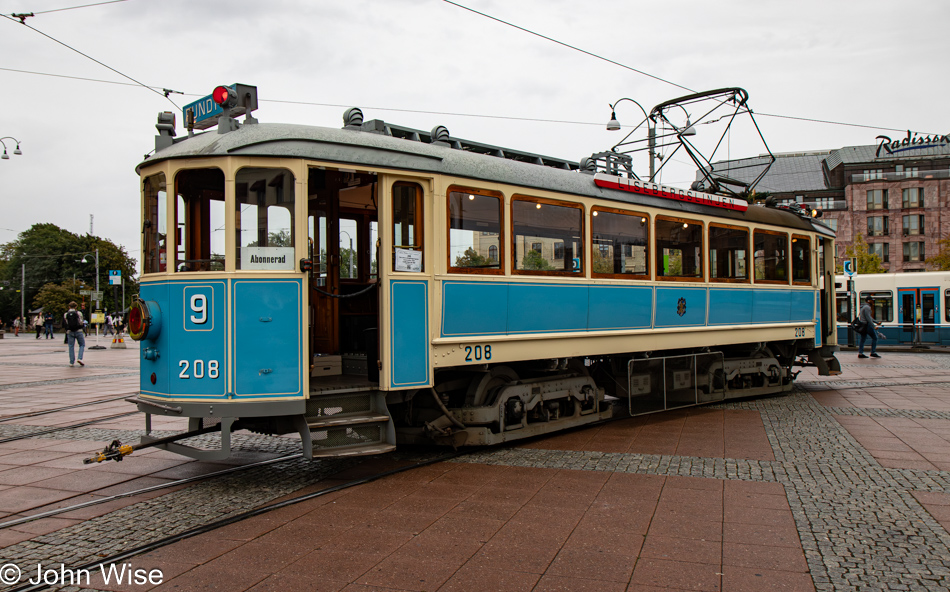
We’ve arrived in Gothenburg (pronounced Yotta-bourry in Swedish), and I need to find a church to beg forgiveness for my transgressions of entertaining murderous aspirations, but it better be Catholic as a Protestant church will do nothing for my soul.
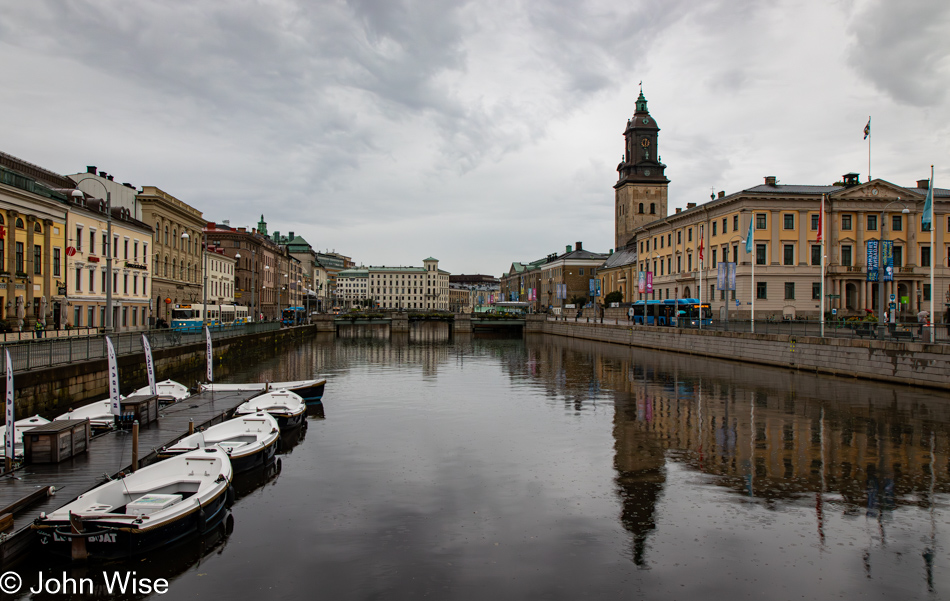
A not-so-funny thing happened on the way to check into our hotel: a wheel on our suitcase crumbled into half a dozen pieces, and now we are pulling the loudest-ever clickety-clackety suitcase over cobblestones. This would be okay if we were willing to go buy another bag, but we’d rather suffer the indignity of disturbing the peace of anyone within a block distance than give up 30 minutes of vacation trying to find a replacement that can wait until we return to Arizona, we hope.
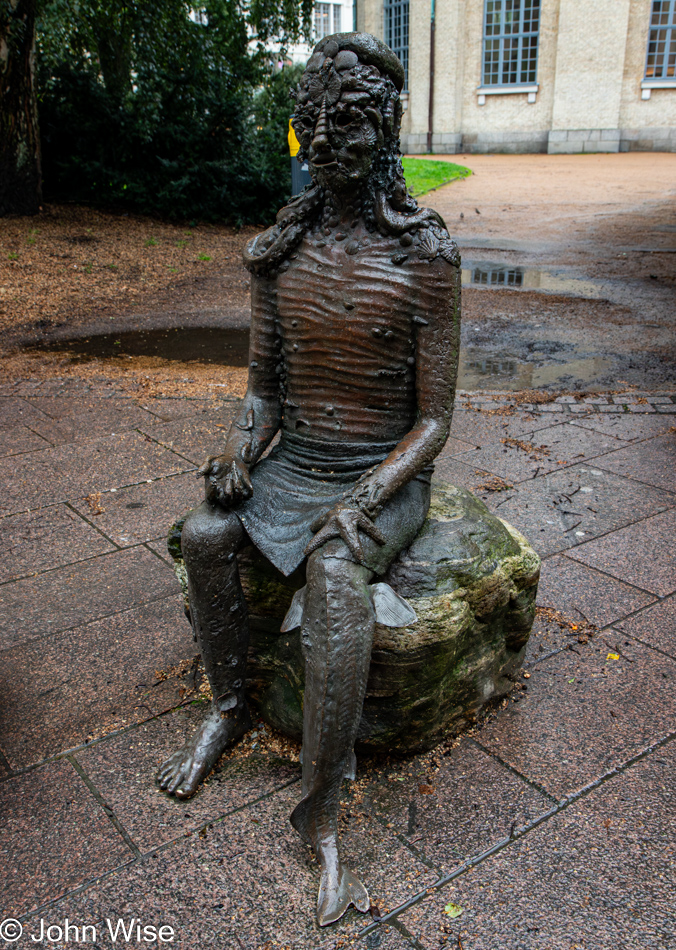
Outside the Gothenburg Cathedral sits this statue; she’s known as the Oraklet (The Oracle). This was an early rendition of The Little Mermaid back when Hans Christian Andersen was still floating the idea of writing something along the lines of Mary Shelley’s The Modern Prometheus but was angling for a seafood connection.

Starting in 1621, a stave church stood here, followed by a cathedral, then another cathedral, and then finally this one. Over the course of less than 100 years, two cathedrals burned down, along with a high school and 290 houses in total, until this rather uninspired building became the third cathedral.
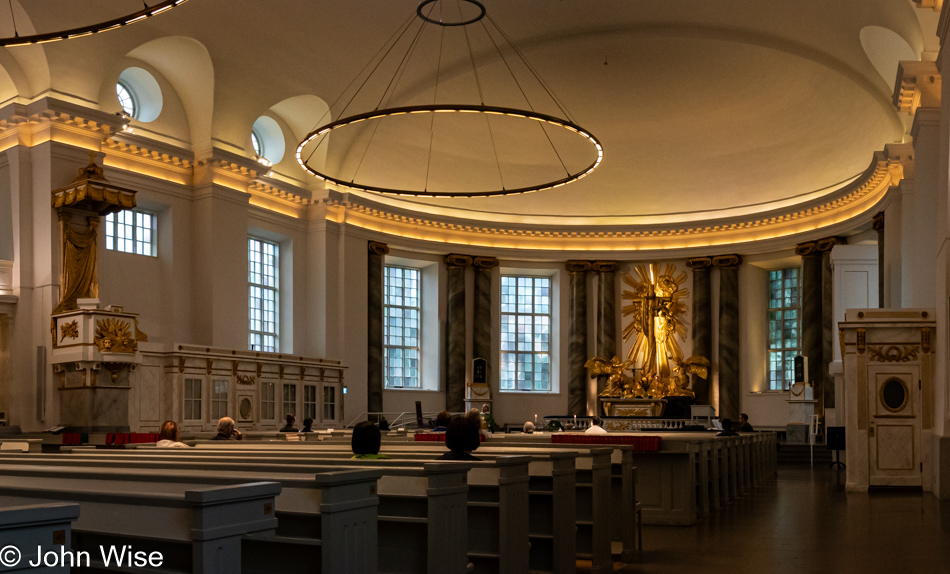
Not feeling the inspiration – from my view, this is the European version of the strip mall church.
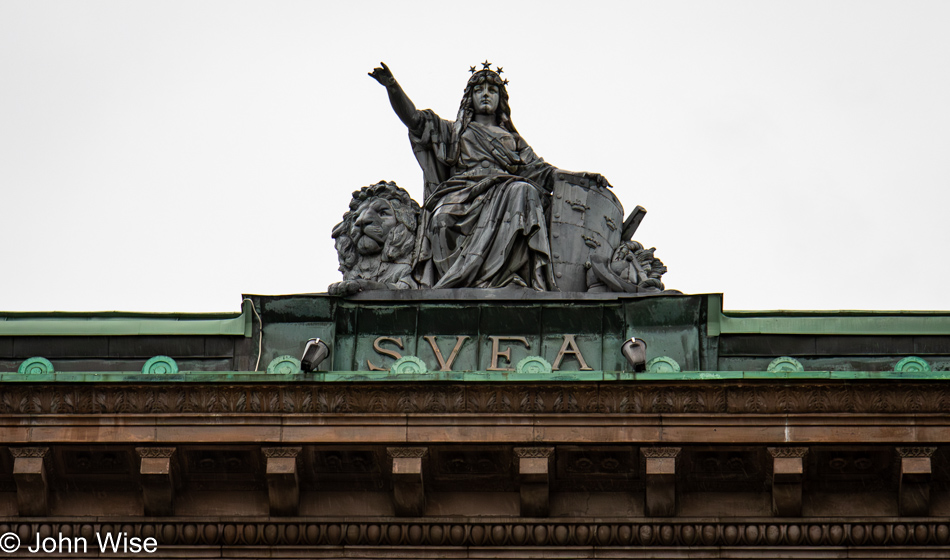
On Västra Hamngatan stands a building with this statue of SVEA, who is the personification of mother Sweden.

One of approximately 30 public drinking fountains found across the city.

These small shacks scattered across Europe serve standard fast-food fare, but they are independently owned mom-and-pop operations that offer variety when everything else is a franchise. Maybe I have some kind of nostalgic feeling for them as they trigger old memories of diners and something from my own past that doesn’t seem to exist on the shores over the Atlantic anymore.
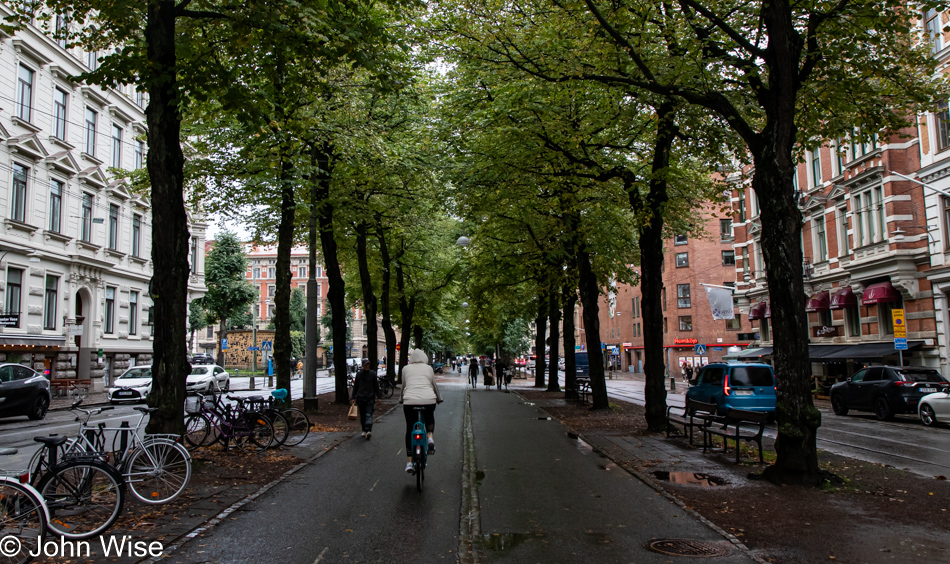
I could be mistaken, but I’d swear this is Swedish Wiesbaden. Of course, you’d have to know something or other about that German city.

Walking through the shopping area, most everything is closed, but window shopping might be more satisfying as it means we don’t have to waste time stopping in every other one.

The girl at the front desk of our hotel told us about a no-frills restaurant called KöttbulleKällaren, which serves, you guessed it, Köttbullar (Swedish meatballs). They were definitely on the large side, covered in something that could be called brown gravy, a weak concoction of lingonberry, and some rather chunky mashed potatoes, but it was cheap, and we were fed.
This is the window display of the oldest tea and coffee shop in Gothenburg called Indiska Thé & Kaffe Magasinet; the place is an artwork in its own right.
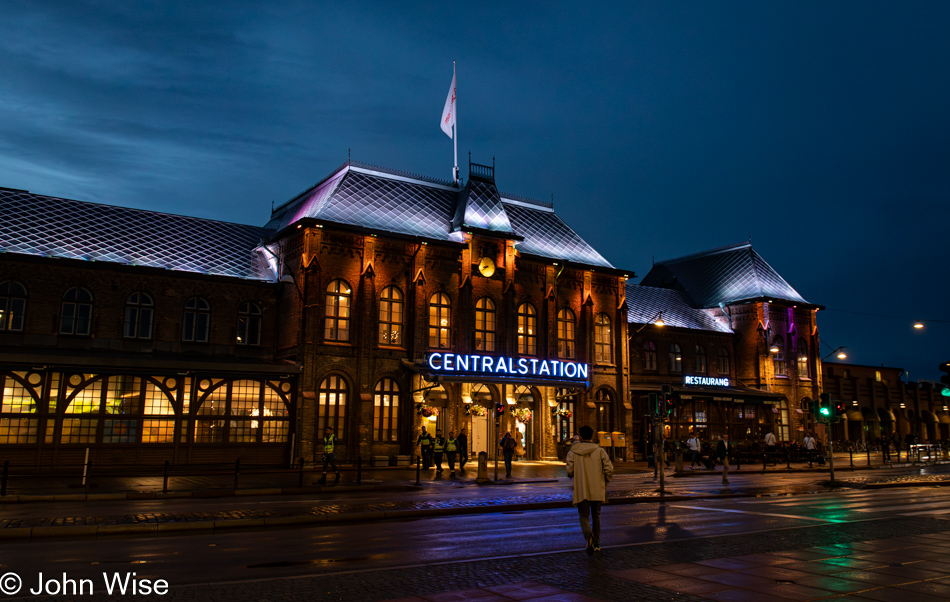
We’re back at the Gothenburg Central Station because our hotel is nearby and the day for us is over.
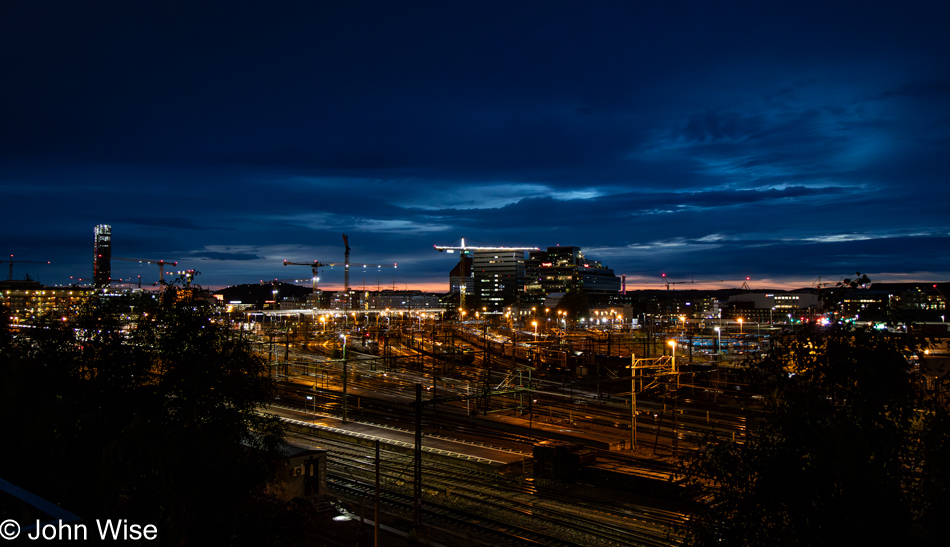
The view from our hotel room is of the railyard. Can you guess that we’re here because it was one of the cheapest in town? Let’s hope for better weather tomorrow so we can see this Swedish city in a better light. But don’t construe that the day could have been any better; we are thrilled about the breadth of our experiences in Sweden on our third day here.
One Reply to “Lund to Gothenburg, Sweden”